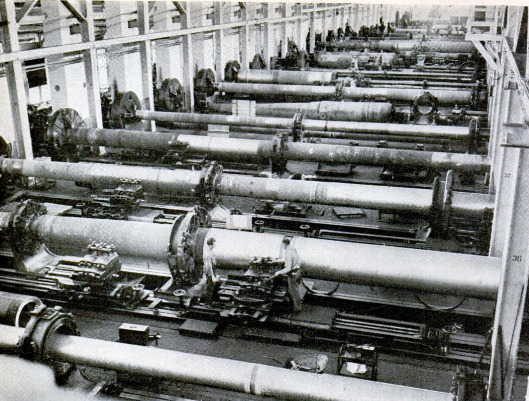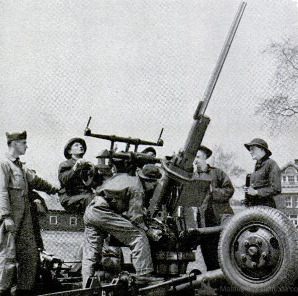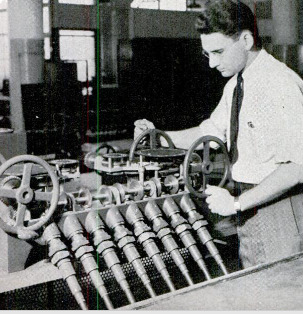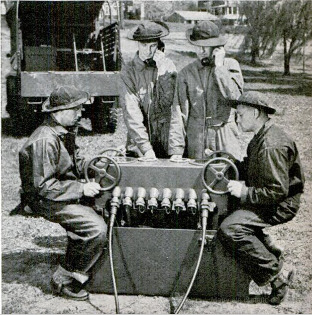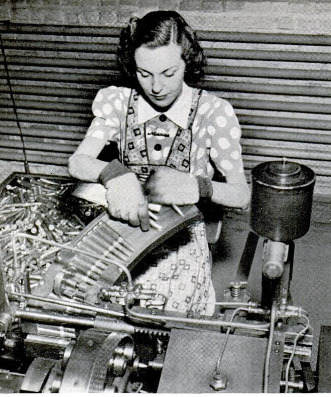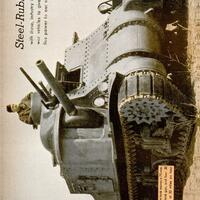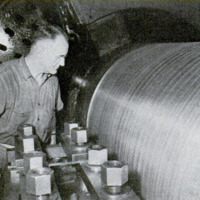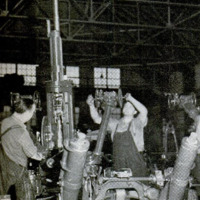-
Title (Dublin Core)
-
Steel rubber oil battle of the billions
-
Article Title and/or Image Caption (Dublin Core)
-
Title: Steel rubber oil battle of the billions
-
extracted text (Extract Text)
-
IT LOOKS like some outsider is continually
forgetting that we Americans are a nation
born with the smell of machine oll in our
hair and that if we are crowded too hard we
are liable to stop making electric refrigera-
tors and pretty automobiles and devote all
our attention to turning out the durnedest
flock of airplanes, tanks, and battleships the
world has ever seen. The first time this
happened to ua there wasn't even a rusty
musket_aplece to go round, and foxy old
Uncle Ben Franklin solemnly proposed—
and the other party believed him!—that if
we were to put up any fight at all we would
have to equip at least one regiment of the
Continental Army with bows and arrows.
We were in the subcellar of unprepared-
ness If there ever was such a place, for
there wasn't a single power-driven lathe on
the whole North American continent. Just
the same, from the backwoods forges of the
Green Mountains and from the Lancaster
County hills of Pennsylvania there came an
ever-increasing supply of long-barreled ri-
flea 50 deadly that no person with a grain of
horse sense dreamed of wearing a red jacket
within 300 paces of the muzzle of one of
those nasty things.
Now once more a bad-acting outsider has
forgotten that on no less than five im-
portant occasions in our history we have
changed practically overnight from a nation
of easygoing Yankee tinkers to a tough
army of grim-faced sweating gunsmiths.
Our’ present. national defense program, in
addition to providing us with a two-ocean
navy and the largest and most powerful
mechanized army necessary to meet any
conceivable emergency, also proposes to
supply the tools of defense to any good-
neighbor country threatened by ruthless in-
vaders,
Tt is futile to attempt to appraise this
Gargantuan defense program In terms of
the billions piled on billions it is going to
cost, for the keenest human intellect can
not comprehend the magnitude of even one
billion dollars. However we are warned by
William L. Batt, Deputy Director, Division
of Production, Office of Production Man-
agement, that Germany is now spending the
equivalent of 20 billion American dollars
per year on her war program and that we
must be prepared to exceed that. Or, by way
of comparison, the Panama Canal, which
required ten years to build at a cost of ap-
proximately a half billion dollars, has long
been considered one of the great man-made
wonders of the world; but our present na-
tional defense program calls for the equiv-
alent of the effort necessary to construct
not one but 40 Panama Canals, not in ten
years but in one year!
How desperately unprepared was the
United States for assuming this role as the
arsenal for all good-neighbor nations is re-
vealed by the fact that less than two years
ago almost 70 percent of our metal-work-
ing machinery—on which this vast quantity
of arms must be manufactured—was more
than ten years old. Much of this over-age
machinery has depreciated until it is now of
little use to the national defense program.
As every machinist knows, you cannot
work to tolerances of a fraction of a thou-
sandth of an inch on a worn-out lathe. To
build a ponderous 28-ton tank, which has
the outward appearance of having been
hammered out by an angry blacksmith,
actually requires hundreds of machine op-
erations where errors of just one thou-
sandth of an inch cannot be permitted. To
complicate the problem further, the manu-
facture of machine guns, torpedoes, bomb
sights, and airplane engines involves many
machine operations where an excess error
of one tenth of a thousandth turns an ex-
pensive part into worthless junk.
All of which means that vital elements of
the national defense program can be pro-
duced only on new machine tools specially
‘manufactured to super-accurate dimensions
themselves. This has created a frantic de-
mand for what can be called the master
machines of national defense, and our only
source of supply is the American machine-
tool industry which just missed mass bank-
ruptey by the skin of its teeth in struggling
through ten years of depression.
The last good year for the machine-tool
industry had been 1929, when it did less
than 200 million dollars worth of business.
Orders slumped to less than 30 millions in
1933, and at fire-sale prices at that. Just a
year ago the United States Government be-
gan to realize the gravity of its unarmed
position in a world seething with wars of
invasion. Official attention then was di-
rected upon the machine-tool industry.
Which is to say that overnight every maker
of lathes, drill presses, precision grinding
machines, gear cutters, milling machines—
all metal-working machines
needed for the production
of defense articles — was
asked to stoke up that idle
boiler in his power plant
and start building machine
tools on a day-and-night
working schedule.
For the year 1940 the machine-tool in-
dustry boosted production from that all-
time low of less than 30 millions to 400
millions, or an increase of 1,300 per cent!
But this was barely enough to equip a few
pilot lines for the production of defense ma-
terials in limited quantities. The industry
was called upon to double production again
and is well along to fulfilling its promise to
supply 750 million dollars worth of desper-
ately needed master machines for 1941.
‘William S. Knudsen, co-director with Sid-
ney Hillman, of the Office of Production
Management, in a recent address warned
the nation that the production of national
defense materials cannot be achieved on any
easygoing “business as usual” basis. Big
Bill, who when he talks about mass produc-
tion never talks foolishness, listed the fol-
lowing huge production schedule as only
part of the main program:
50,000 airplanes (Plus an additional 500
heavy bombers per month ordered re-
cently by the President.)
130,000 aviation engines
17,000 heavy cannon
25,000 light cannon
13,000 trench mortars
33,000,000 artillery shells
300,000 machine gins
400,000 Garand semiautomatic rifles
1,300,000 Springfield rifles, with bayonets
113,000 motor trucks
25,000 trailers
106,000 field telephones
144,000 miles of telephone wire
Plus—a two-ocean Navy, and 200 addi-
tional cargo ships!
Big Bill warns that this is a full-time job
for every skilled worker, for our best man-
agement brains employing our finest ma-
terials and requiring the erection of hun-
dreds of additional factories. This job, he
says, will require 28 billion man-hours of
skilled labor during the next 28 months.
“Every machine shop and every foundry in
the United States which can make even a
piece of something must be enlisted for the
duration.” He might well have added, yes,
and every basement hobby-shop enthusiast
will be called upon to turn out small de-
fense parts after his regular work is done.
Many are the emergency methods being
employed to provide an ample supply of
skilled labor where it will be most needed.
The U. S. Employment Service is calling for
all workers outside the national defense pro-
gram who have unused skill to register im-
mediately at their local state free employ-
ment offices. This appeal was made espe-
cially to older men who had left their trades
and who had become discouraged by trav-
eling hit-or-miss about the country looking
for work. Register at your local state em-
ployment agency if you are a skilled me-
chanic, is the advice right now. Then sit
tight and a defense job will hunt you up.
Public schools throughout the country are
installing secondhand machine tools of the
type most nearly like those used in local
defense plants, so that unskilled workers
can receive basic training and semiskilled
workers can be graded up in skill
Y. M. C. A. night classes have been or-
ganized for the same purpose and many
private trade schools are doing effective
worker training. The National Youth Ad-
ministration and W. P. A. are also con-
ducting worker training courses.
One of the interesting sidelights of the
defense program is the manner in which
newspaper editors have taken the reports of
raw-material prices and supply off the in-
side back page and are now displaying them
as page-one news. The “Big SIX" of the
raw materials these days are Rubber—
Aluminum — Copper — Petroleum — Steel—
Coal. These make the headlines because of
the vast quantities of each consumed daily
by the defense program. Steel, with its
components coke, limestone, and iron ore,
forms the backbone of the defense program,
naturally. The job of moving iron ore from
the upper Great Lakes ports is one of the
really tremendous transportation problems
of the world. More cargo tonnage passes
through the Sault Sainte Marie locks in the
nine months of the Great Lakes navigation
season than is handled in 12 months by the
Panama and Suez canals combined.
Recently aluminum has made headlines
on page one of our newspapers. The domes-
tic demand for aluminum in a brisk busi-
ness year used to run about 300 million
pounds. The demands for airplane con-
struction have increased consumption to
700 million pounds for this year, while the
estimated requirements for 1942, when mass
production of planes is expected to really
get going, may run as high as a billion
pounds. It is only natural then that alumi-
num was the next item after machine tools
placed on the priorities list by the O.P.M.
Copper, like aluminum, is needed in vast
quantities for defense. It is used in the
manufacture of electrical goods—wire, mo-
tors, powerplant generators—and soon
will be in heavy demand as the base metal
for brass cartridge cases. Domestic sup-
plies of copper ore and smelting capacity
are sufficient for almost any possible need.
Petroleum is worrying the Axis partners
far more than it need worry us with our al-
most unlimited supply, which is to be avail-
able not only for ourselves but for all other
nations eligible under the Lease-Lend Act.
Germany and Italy are being forced to carry
on the aggressor's burden of the war with |
only five percent of the petroleum products, |
both synthetic and natural, which the Unit- |
ed States is now producing. |
The Axis partners are especially short of |
100-octane gasoline, of which we have an
abundance and with still more refining car
pacity being built. This 100-octane gas- |
oline means that a supercharged airplane |
engine designed for use with it will deliver
20 percent more horsepower than another
engine using 90-octane gasoline, It so hap- |
pens that 90-octane gasoline is the best Ger- |
many so far has been able to produce, and |
then in such limited quantities that only |
careful rationing, to the utter exclusion of |
nonmilitary consumption, keeps her war
machine from stalling.
Dr. Robert E. Wilson, petroleum expert |
of O.P.M, recently made this report to a |
congressional committee: “The gasoline con-
sumption of Germany during the few weeks |
of fighting in the low countries and France
exceeded the entire consumption during the |
entire first World War.” Yes, our petro- |
leum and 100-octane gasoline production is |
critical—for Germany. |
Other raw materials are being carefully
husbanded by the materials division of |
O.P.M. We use annually more than 500,000 |
tons of chromium ore in the manufacture of
stainless steel, high-speed steel, and special |
steel for ball bearings and nonshrinking die |
steels. A large part of this tonnage of |
chromium ore is used without metallurgical |
refining in the production of firebrick for |
steel-melting furnaces.
At the present time most of our chromite
ore is imported from Africa and the Phil-
ippine Islands, over trade routes that may
be interrupted at any moment. But a year's
reserve of high-grade ore, over and above
current arrivals from abroad, gives us suf-
ficient leeway to develop American low-
grade chrome-ore deposits and expand our
existing ore-treating plants.
Curtailment of our tin supply, which
comes from British Malaya and the Dutch
East Indies, is also possible. But here again
we have created a reserve to last a year
with careful rationing. Meanwhile our
South American neighbor, Bolivia, is pro-
viding us with 18,000 tons of ore per year.
The greater part of the 90,000 tons of tin
we import annually goes into the countless
millions of tin cans used by the food-can-
ning industry. New lacquer coatings for
untinned sheet steel have proved adequate
as a substitute on food containers. Glass is
also available—as the farm wife well knows
—as a substitute for tin cans, and at slight-
ly higher cost silver could be used. It is
estimated that the cost of a can of tomatoes
would increase not more than three cents if
packed in a silver-plated can—extra for
engraving your initials, of course.
Since every metal-working machine must
have efficient cutting tools, tungsten also
has become a strategic raw material. High-
speed tool steel requires 18 percent metallic
tungsten to make it able to peel off red-hot
steel chips without losing its temper. Most
of the 500 tons of high-grade tungsten ore
we import per year comes out over the long
and tortuous Burma Road from the interior
of China. This source may be cut off at any
time, as it recently was when the Burma
Road was closed temporarily. Our reserve
supply is almost nil, aside from what high-
speed steel scrap is in the hands of scrap-
metal dealers and the steel mills. We have
a five months’ supply at best, but again
fortunately we have a substitute. This is
molybdenum. One mountain in Colorado |
can supply all the molybdenum we will ever
need as a substitute for tungsten in high-
speed steel.
Another development of metallurgy has |
provided an even more efficient cutting met- |
al than tungsten steel. This is tungsten car- |
bide. Small bits of tungsten carbide when
welded to less expensive steel shanks actual-
ly cut metal faster than 18-percent tungsten
steel, and also hold an edge much longer be-
tween regrindings, thus saving at least 20 |
percent of the time a machine is idle while |
tools are changed. The really important
feature of tungsten carbide, however, is the
fact that one pound of tungsten carbide re- |
leases 100 pounds of precious metallic tung-
sten for the more essential defense needs—
such as tips for armor-piercing shells.
Some 72 raw materials are essential to
the national defense program, with now and |
then a material like magnesium—a metal |
lighter than aluminum and now being used
in increasing quantities for airplane-motor |
castings—making the headlines for a day or
two, only to be forgotten by the public as |
soon as it learns that a new magnesium |
plant just recently erected on the Gulf of |
Mexico is tapping the unlimited reserves of |
this metal in sea water! Zinc will be men- |
tioned in connection with what agriculture |
is contributing in the way of raw materials
for defense. There still remain to be men-
tioned antimony, industrial diamonds, man-
ganese, nickel, beryllium—a new metal em- |
ployed in hardening armor plate and for |
machine-gun parts—cobalt, graphite, as-
bestos, cotton, mercury, and so on down
through the list. In none of these materials
could a serious shortage arise.
Of all defense raw materials obtained
from distant foreign sources, “rubber” is
the fighting word that would instantly send
the United States battle fleet steaming west-
ward with its decks cleared for action at the
first authentic news that some enemy power
was intercepting American merchant ships
laden with crude rubber. Our annual con-
sumption of crude rubber is something near
700,000 long tons, mostly imported from
British Malaya and the Dutch East Indies.
This supply may be cut off at any time.
Meanwhile the best minds studying the
rubber problem are busy devising a second
line of defense, should our supply of crude
rubber from the Orient fail. Excellent syn-
thetic rubber products are being made in
limited quantities from petroleum and vari-
ous gases in combination with other ele-
ments. Synthetic rubber production at
present meets less than two percent of our
minimum requirements, while
3,000 tons of guayule rubber,
extracted from a shrub that
grows wild in Mexico and our
own Southwest, and about
20,000 tons from South Amer-
ica. constitute our only other
sources of crude rubber.
1t is obvious that our rub-
ber problem would be serious,
if not critical, if it not were
for the fact that in the junk
yards of America and hang-
ing from nails in almost
every private garage, there
are hundreds of thousands of
tons of reclaimable rubber in
discarded automobile tires.
Chemical and mechanical
processes now can extract this
scrap rubber and restore it
largely to its original state
of usefulness.
Paul W. Litchfield, chair-
man of one of the largest
rubber-processing plants in
the world, estimates that
from these garage nails and
junk piles a two years’ sup-
Ply of vitally needed rubber
can be reclaimed. Don't be
surprised some day to hear a
voice over your radio asking
you to go out to the garage
and unhook that old tire
from the nail and turn it in
as your personal contribution
to the national defense pro-
gram.
The defense role of chemurgy, the new
science of converting farm products into in-
dustrial materials, is described elsewhere in
this issue. From soybeans it makes plastics
that will release much-needed zinc for the
‘manufacture of cartridge-case brass. Soy-
bean ofl will yield stearic acid for use in the
‘manufacture of tires and to increase the
supply of glycerin for explosives. So the
farm tractor may well be considered as en-
listed for national defense, side by side with
its tough big brother the 28-ton tank.
Machines and raw materials are vital to
the national defense program. But it is man-
power—the manipulation of machines and
processes by skilled hands and intelligent
brains—that must be counted on to build
the complicated weapons we need.
Not much over two years ago a skilled
‘mechanic over 40, unlucky enough to be out
of a job, was considered all washed up and
with no future but a pick-and-shovel job on
a relief project. All that has been changed
by the national defense program.
Recently the manager of a large saw
works producing lightweight armor plate
for fighting planes pointed out to a visitor
a giant plate-edging machine being run by
a spry old man,
“We bought that machine secondhand be-
cause we couldn't get delivery of a new one
in time,” explained the manager. “But we
got a bad scare when we discovered that not
one of our 800 men knew beans about op-
erating this monster. Then into our em-
ployment office walked a white-haired old
mechanic who said he had been reading in
the papers how the defense program needed
all the machinists it could muster. Would
we let a man of 75 show what he could do?"
‘The plant manager pointed to the old man
on the big machine. “It sounds like a fairy
tale, but our employment man played a
hunch and took this old-timer out into the
plant and showed him this machine. ‘If you
can make that balky thing walk the dog,
sald our employment man, ‘you're hired."
“For a moment,” went on the plant man-
ager,” the old man just stood there fighting
back the tears. Then he said, ‘Mister, ten
years ago I was laid off because the factory
where I worked went bankrupt and sold off
all its machinery at auction. That big ma-
chine, standing right there, is the one I used
to run. Mister, I'll make that machine knit
lace curtains if you say the word!”
As more and more new machinery ar-
rives and still more plants get rolling on
mass production of defense materials the
cry will be for more and still more skilled
men. Otto W. Winter, chairman of the
Emergency Training Committee, American
Society of Tool Engineers reports: “Skilled
labor and technical labor requirements re-
veal a shortage of 1,250,000 men.”
Other surveys indicate that to meet the
peak still to come an additional 4,000,000
skilled men will be needed. The training and
morale of this vast army of defense workers
is already recognized as being of equal im-
portance and worthy of equal praise to that
of the men in uniform. A nation of 130 mil-
lion free people has spit on its hands and is
tackling the problem of building an over-
whelming stock of all the tools of war.
-
Contributor (Dublin Core)
-
Ray Millholland (article writer)
-
Language (Dublin Core)
-
Eng
-
Date Issued (Dublin Core)
-
1941-08
-
pages (Bibliographic Ontology)
-
57-62
-
Rights (Dublin Core)
-
Public domain
-
Archived by (Dublin Core)
-
Sami Akbiyik
 Popular Science Monthly, v. 139, n. 2, 1941
Popular Science Monthly, v. 139, n. 2, 1941


